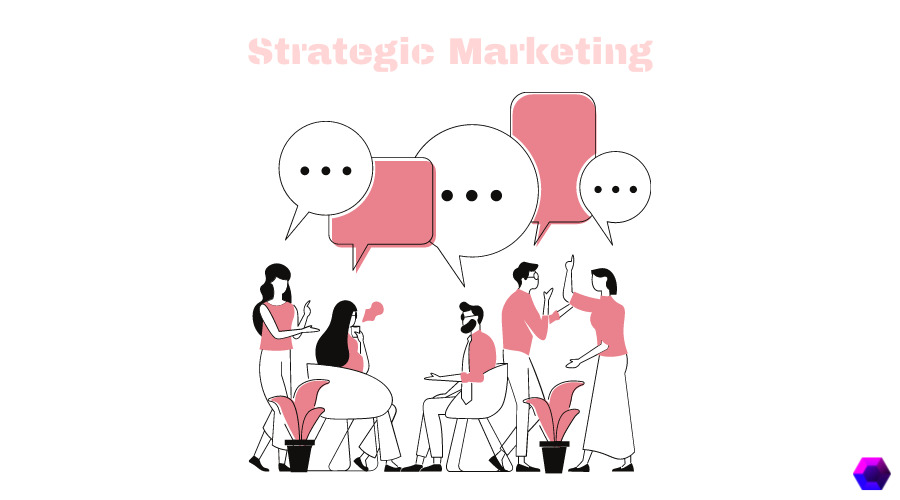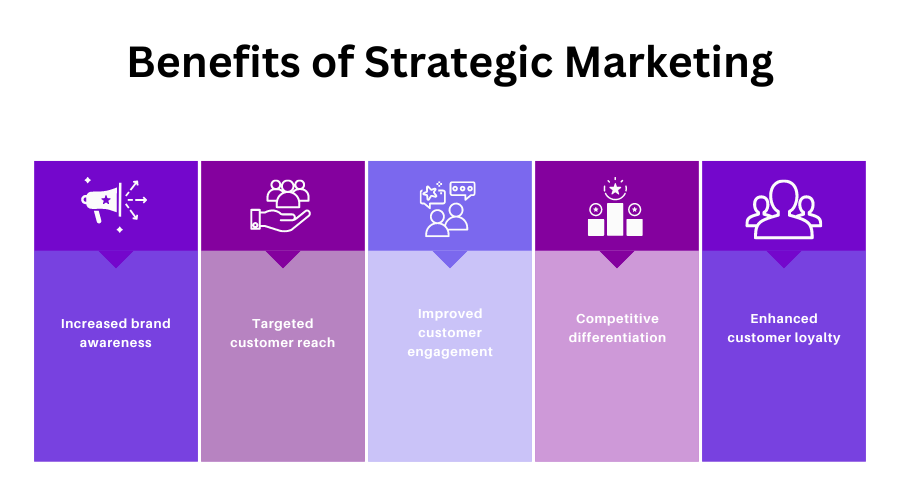What Is Strategic Marketing? Definition & Its Process
October 26, 2023 Max 7min read

This article covers:
Is it safe to interpret that ‘digital’ is now a significant aspect of your marketing strategy? Yes.
Sun Tzu once said “Tactic without strategy is the noise without defeat,” highlighting the importance of strategic thinking in marketing. Strategic planning is not just limited to merely promoting products or services. It involves carefully planning and executing well-thought-out strategies to achieve long-term business goals
Want to learn all about it and learn why it is vital to business success? Then keep reading.
What Is Strategic Marketing?
Strategic marketing definition:
Strategic marketing is what companies do when they have a written marketing strategy that guides all of their activities. It is long-term in character and serves as the foundation for all marketing decisions. Strategic marketing is a viable plan for gaining a specified marketing-related goal (or goals). It considers what your company is already working well and what you’re missing in your dream, making you more likely to achieve it.
Strategic marketing has grown in popularity inside businesses over the last few years. However, there is still considerable misunderstanding about strategic marketing and its function in industries.
Strategic marketing, often known as marketing strategy, is a concept you may hear frequently but may not wholly comprehend and is solely relevant to larger businesses. In reality, strategic marketing thought should underpin all marketing activities undertaken by a small organization.
However, the ever-changing digital landscape may rapidly become daunting when a firm grows. How do you efficiently establish, fine-tune, and manage an agile digital marketing tactics while juggling various other duties and tasks?
Follow us along!
Read: Difference Between Strategic Thinking and Strategic Planning
What Is the Distinction Between Marketing and Strategic Marketing?
Let’s look at what marketing is and how it varies from strategic marketing.
The distinction between marketing and strategic marketing is similar to the difference between a piece of cheese and using that piece of cheese to make some delicious lasagna . While the former is great on its own, it pales in comparison to its use as part of a larger plan that maximizes the benefit of all components.
Marketing efforts are put to plan using a variety of tools and strategies. The 4P’s of marketing, often known as the marketing mix, are essential tools and approaches that marketing specialists can utilize to align their marketing operations with company objectives (price, product, place, promotion).
The 3C’s, corporation, customer, and competition are strategic marketing tools and strategies. According to Mintzberg, top strategic marketers spend most of their time analyzing each of the 3C’s to build a market strategy successfully.
Marketing promotes the company, its brand, and its products. Strategic marketing, on the other hand, aids business growth and success by providing a competitive advantage. It combines targeted marketing methods with common goals, whereas marketing on its own is often a pointless activity.
What Is the Purpose of Strategic Marketing?
Marketing plans reveal the goal of strategic marketing. Organizations have found that plans containing this type of marketing are critical to achieving positive results in areas such as product and brand recognition and retaining and expanding their customer base. It highlights this approach’s ability to refine organizational objectives.
Strategic marketing is the implementation of marketing disciplines to gain corporate objectives by creating and maintaining a sustainable competitive advantage. It covers high-level issues, including which markets to target, which services to provide, and how to price and promote them.

Factors That Can Make and Break Strategic Marketing?
Your marketing strategy is arguably one of the most crucial components of expanding your business.
You’ll be able to flesh out things such as prospective new growth prospects, which your actual customers are against who you thought they were, how to acquire more customers, and where to spend future marketing expenditures with an effective marketing plan.
Your Knowledge of Your Intended Market
Every marketing strategy has a specific target market in mind. Even if you’re unsure who you should target, start with information you already have. Finding out about your target audience’s demographics is good to start and create a buyer’s persona once you’ve nailed down the demographics.
Communicating The Value To Your Customers
Even the most stunning marketing methods won’t work until your customers understand the value of your product or service. It would help if you adequately described the benefits of your product.
Data Monitoring
There’s no excuse for not keeping a tight check on the data these days, especially with Google Analytics, a free marketing analytics tool. Companies can track which web pages generate the most hits, how long visitors remain on pages, where visitors come from, and much more, thanks to marketing data. Failure to devote the necessary time to data analysis can result in the loss of the overall marketing strategy.
Focus
The most successful businesses prioritize customer service before profit. Placing customers ahead of profits is counterintuitive, yet it works. “As soon as your firm focuses on providing value to clients, an almost spontaneous growth develops that is almost incomprehensible,” explains Marine-creator.
Include your marketing staff in R&D meetings and look for other ways your organization may provide value to people’s lives to achieve this level of attention.
What Are the Five Steps of the Strategic Marketing Process?
The strategic marketing planning process allows marketers to assess their own and their competitors’ industry positioning and the techniques that can help them reach their target audience, answer consumer wants, increase brand awareness, and achieve other marketing and commercial objectives.
The steps to a successful strategic marketing approach are below.
1. Create a Mission Statement, Goals, and Objectives
Before you do anything else, get down with your marketing executives and stakeholders and identify your company’s mission and the goals and objectives that will drive your strategic marketing.
2. Situation Assessment
Evaluating internal and external elements that affect your organization and market is the second step in the strategic marketing process.
Your study will reveal your strengths and the challenges you face, whether they are related to internal resources or external competitors.
Situation analysis delivers a clear, realistic picture of your company’s health, present and future consumers, industry trends, and market position.
3. Develop Marketing Strategies
Consider your marketing mix that relies on the 4 Ps of marketing.
Product: The goods or services your company provides in answer to client desires and demands.
Price: The product’s cost and the value it provides to the buyer.
Place: The location where you are planning to sell your product or service.
Promotion: Your product’s marketing activities, which may include messaging tailored to your target market.
The physical and digital distribution channels that you use to facilitate sales.
4. Start Using Your Process
Execution is the final phase.
The content development process is now in motion, with benchmarks established, investments made, and agreed-upon strategies. You’ll need to collect and validate all data related to your marketing activity in addition to developing content.
5. Control and Implementation
It’s now time to put your strategy into action. Determine how and when you will implement your plan. You will contact clients at this step of the strategic marketing process to inform and persuade them about your product or service.
What Are Strategic Marketing Examples?
Looking for some marketing strategy examples that can motivate you? It’s right here!
The marketing ecosystem is constantly changing, and it’s impossible to keep up with new trends, methods, and technologies. You can’t prosper if you’re trapped in the past and adopt outdated marketing tactics.
Spotify: Offer a Different User Experience
Spotify is one of the most well-known global brands today, but how did this Swedish company get popular? Spotify stands out as the first among the many streaming music providers because it focuses on helping consumers find new content.
Spotify, for example, allows users to choose music depending on their moods in addition to the standard genre filter. We’ve got you covered up whether you want to work out, sleep, or even sing in the shower!
Coca-Cola: Champion of Cause
Customers have the opinion that brands exploit social causes as a marketing technique,. This is one of the reasons why consumers are skeptical of brands. On the other hand, Coca-Cola has defied the stereotype by promoting “happy.”
In Brazil, Coca-Cola developed “The Happiness Track,” a red truck that toured the streets and gave away free items to everyone who pressed the red button on the car.
The “sharing is caring” campaign aided the brand’s positioning in international markets.
Looking for the most successful growth marketing methods for generating leads and boosting sales? This article serves as a comprehensive guide to it. I hope you found it interesting!
FAQs
Failure to design a marketing strategy can lead to financial issues, low consumer volume, and business collapse in the worst-case situation.
Strategic marketing aids in the development of profitable products and services for the company. This is because strategic marketing begins with a SWOT analysis of the company, a consumer market analysis, and a market trend analysis.
